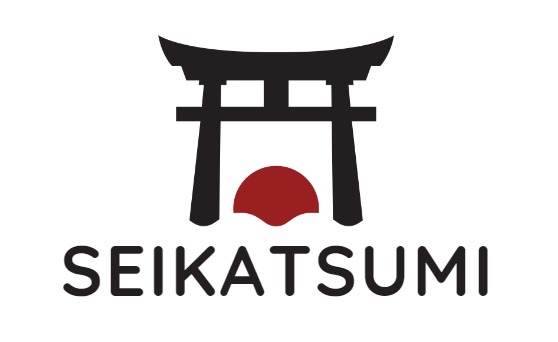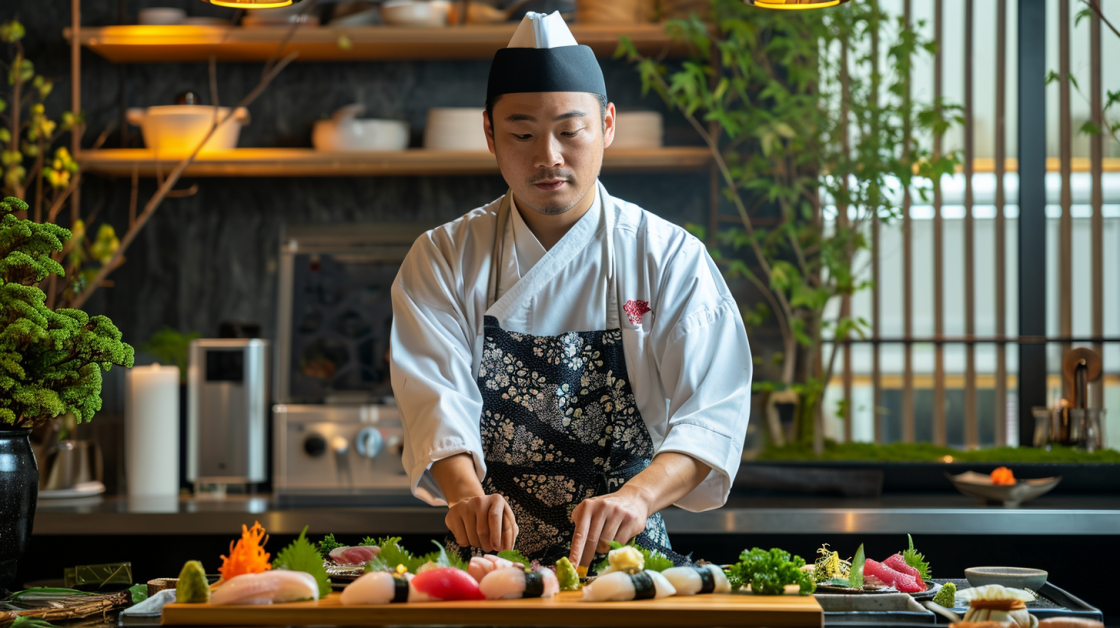Are you passionate about keto Japanese food cuisine? I absolutely share your enthusiasm!
I understand the challenge of finding low-carb options that still capture the essence of traditional Japanese flavors.
That’s why I’ve dedicated time to exploring and experimenting with keto-friendly Japanese recipes.
So, why wait? Join me in this culinary adventure and explore the delicious possibilities! 🙂
Basics for Keto Japanese Food
As someone who follows a Keto Japanese Food diet, you might think that Japanese cuisine is off-limits due to its emphasis on rice and noodles.
However, there are plenty of keto-friendly options available in Japanese cuisine that you can enjoy without worrying about your carb intake.
One of the essential components of the Keto Japanese Food diet is the high-fat content. Luckily, Japanese cuisine is rich in healthy fats such as omega-3 fatty acids found in fish like salmon, mackerel, and tuna.

These fatty fish are staples in Japanese cuisine, and they are perfect for those on a Keto Japanese Food diet. Sashimi, which is raw fish served without rice, is a great option when you’re looking for a keto-friendly meal.
Another keto-friendly option in Japanese cuisine is grilled meat, such as yakitori, which is skewered chicken grilled over charcoal. Grilled meat dishes are a great way to get your protein fix without consuming too many carbs.

When it comes to vegetables, Japanese cuisine has plenty of low-carb options. For instance, edamame, which are boiled soybeans, are a great source of protein and fiber.
Additionally, seaweed is a staple in Japanese cuisine and a great source of vitamins and minerals. Seaweed salad is a keto-friendly option that you can enjoy as a side dish.
Popular Keto-Friendly Japanese Dishes
Are you looking for delicious and healthy Japanese dishes that are perfect for your Keto Japanese Food diet? Look no further than these popular keto-friendly Japanese dishes that are sure to satisfy your cravings!
Sashimi Selections
Sashimi is a traditional Japanese dish that consists of thinly sliced raw fish that is served with soy sauce and wasabi. This dish is perfect for Keto Japanese Food dieters because it is high in protein and low in carbs.
Some of the most popular sashimi selections include tuna, salmon, and yellowtail. These fish varieties are not only delicious, but they are also rich in omega-3 fatty acids, which are essential for maintaining good health.
Keto Japanese Food Sushi Options

Sushi is another popular Japanese dish that is perfect for Keto Japanese Food dieters. While traditional sushi rolls are made with rice, there are plenty of keto-friendly sushi options that you can enjoy.
For example, you can try sushi rolls that are made with cauliflower rice or seaweed wraps instead of traditional rice.
You can also opt for sushi rolls that are filled with avocado, cucumber, and other low-carb vegetables.
Grilled Fish Varieties

Grilled fish is a staple in Japanese cuisine, and it is also a great option for Keto Japanese Food dieters. Grilled fish is high in protein and healthy fats, and it is also low in carbs. Some of the most popular grilled fish varieties in Japanese cuisine include salmon, mackerel, and sardines.
These fish varieties are not only delicious, but they are also rich in omega-3 fatty acids, which are essential for maintaining good health.
Japanese Salads and Sides
Japanese salads and sides are also great options for Keto Japanese Food dieters. Some popular options include edamame, seaweed salad, and. These dishes are not only low in carbs, but they are also packed with nutrients that are essential for maintaining good health.
For example, seaweed is rich in iodine, which is important for maintaining a healthy thyroid gland. Edamame is also a great source of protein and fiber, which can help you feel full and satisfied.
Whether you are a fan of sashimi, sushi, grilled fish, or Japanese salads and sides, there are plenty of options to choose from that are perfect for your Keto Japanese Food diet.
Hey you! Are you interested in more food trends? Then be sure to check out our top food articles! You definitely can’t miss it!
Japanese Sushi Essentials: The Best Guide to Enjoying Traditional Flavors 2024
Low Carb Japanese Food 2024: The Best Guide for Delicious and Healthy Food
Japanese Bento Box: Your Guide Preparing The Best Bento Box In 2024!
Ingredients and Substitutes

As a Keto Japanese Food enthusiast, I have learned how to make healthy and delicious Japanese dishes without sacrificing flavor. If you’re new to the keto diet or just looking to try something new, you might be wondering what ingredients to use and what to substitute.
Low-Carb Rice Alternatives
One of the staples of Japanese cuisine is rice. Unfortunately, rice is high in carbs and not suitable for the Keto Japanese Food diet. But don’t worry, there are plenty of low-carb rice alternatives that you can use instead.
Here are some of my favorites:
- Cauliflower rice: This is a great substitute for rice and can be used in a variety of dishes. It has a similar texture to rice and is low in carbs.
- Shirataki rice: Made from konjac root, shirataki rice is low in carbs and calories. It has a slightly chewy texture and can be found in most Asian grocery stores.
- Kelp noodles: Kelp noodles are made from seaweed and are low in carbs and calories. They have a crunchy texture and can be used in salads or stir-fries.
Noodle Replacements

Noodles are another staple of Japanese cuisine, but they are also high in carbs.
Here are some low-carb noodle replacements that you can use instead:
- Zucchini noodles: Also known as zoodles, zucchini noodles are a great substitute for traditional noodles. They are low in carbs and have a similar texture to noodles.
- Shirataki noodles: Like shirataki rice, shirataki noodles are made from konjac root and are low in carbs and calories. They have a slightly chewy texture and can be used in soups or stir-fries.
- Spaghetti squash: Spaghetti squash is a low-carb alternative to pasta. When cooked, it has a stringy texture similar to noodles.
Soy Sauce and Condiments

Soy sauce and other condiments are often used in Japanese cooking, but many of them are high in carbs.
Here are some low-carb options that you can use instead:
- Coconut aminos: Coconut aminos are a great substitute for soy sauce. They are low in carbs and have a similar flavor to soy sauce.
- Tamari: Tamari is a gluten-free soy sauce that is low in carbs. It has a slightly richer flavor than regular soy sauce.
- Wasabi: Wasabi is a low-carb condiment that adds a spicy kick to dishes. It is often served with sushi and sashimi.
With these low-carb substitutes and alternatives, you can enjoy delicious Japanese cuisine while staying true to your Keto Japanese Food diet.
Cooking Techniques for Keto Japanese Food
When it comes to cooking keto Japanese meals, there are a few techniques that are particularly useful. These techniques can help you to create delicious, healthy meals that are packed full of flavor.
Grilling

Grilling is a popular cooking technique in Japanese cuisine, and it’s perfect for Keto Japanese Food meals. Grilling allows you to cook meat and fish without adding any extra fat, and it gives the food a delicious smoky flavor.
You can use a grill pan or an outdoor grill to cook your food, depending on what you have available.
Steaming
Steaming is another popular cooking technique in Japanese cuisine, and it’s perfect for keto meals. Steaming allows you to cook your food without adding any extra fat, and it helps to retain the nutrients in the food.
You can steam vegetables, fish, and meat, and you can even steam eggs to make delicious keto-friendly egg custards.
Stir-Frying

Stir-frying is a quick and easy cooking technique that’s perfect for Keto Japanese Food meals. It allows you to cook your food quickly and with minimal fat, and it’s perfect for cooking vegetables and meat together.
You can use a wok or a large frying pan to stir-fry your food, and you can add a variety of different spices and seasonings to create delicious flavors.
Using Konjac Noodles

Konjac noodles are a popular ingredient in Japanese cuisine, and they’re perfect for keto meals. These noodles are made from the konjac root, and they’re very low in carbs and calories.
They can be used in a variety of different dishes, including stir-fries, soups, and salads.
Using Shirataki Noodles

Shirataki noodles are another popular ingredient in Japanese cuisine, and they’re perfect for keto meals. These noodles are made from the root of the konjac plant, and they’re very low in carbs and calories.
They can be used in a variety of different dishes, including stir-fries, soups, and salads.
By using these cooking techniques and ingredients, you can create delicious, healthy Keto Japanese Food that are packed full of flavor.
Eating Out: Keto Guide to Japanese Restaurants
As someone who follows a keto diet, eating out can be a challenge. However, Japanese cuisine offers plenty of keto-friendly options.
Here are some tips for ordering Keto Japanese Food at Japanese restaurants:
Sashimi is Your Best Friend

Sashimi is a dish consisting of thinly sliced raw fish and is a great option for those on a keto diet. It’s high in protein, low in carbs, and contains healthy fats.
When ordering sashimi, be sure to ask for it without any sauces or rice. You can also request to add avocado or cucumber for some healthy fats and fiber.
Skip the Rice, Opt for Salad
Rice is a staple in Japanese cuisine, but it’s not keto-friendly. Instead, opt for a salad or seaweed salad as a side dish. These options are low in carbs and high in nutrients. Be sure to ask for dressing on the side to control the amount of added sugar.
Choose Grilled or Steamed Options
Tempura, a popular Japanese dish, is made with flour and other starches, making it high in carbs.
Instead, choose grilled or steamed options such as yakitori (grilled chicken skewers), shabu-shabu (hot pot), or sukiyaki (beef stew). These dishes are high in protein and low in carbs.
Beware of Hidden Carbs

Teriyaki sauce and other sweet sauces are high in carbs and sugar. Be sure to ask for sauces on the side or avoid them altogether. Some sushi rolls also include tempura shrimp or veggies, which should be avoided.
Instead, opt for plain shrimp and veggies (with no tempura) or sashimi.
By following these tips, you can enjoy delicious Japanese cuisine while staying on track with your Keto Japanese Food diet.
Keto Japanese Desserts and Snacks

If you have a sweet tooth, you don’t have to give up on Japanese desserts just because you’re following a keto diet. There are plenty of keto-friendly Japanese desserts and snacks that you can enjoy guilt-free.
One popular keto Japanese dessert is matcha ice cream. Made with matcha powder, heavy cream, and sweetener, it’s a delicious and refreshing treat that’s perfect for a hot summer day.
You can also try making mochi, a traditional Japanese dessert made from glutinous rice flour. Simply substitute regular flour with almond flour and use a low-carb sweetener instead of sugar.
For a quick and easy snack, try edamame. These soybeans are a popular Japanese snack and are packed with protein and fiber. You can also try making your own keto-friendly version of onigiri, a rice ball snack.
Simply use cauliflower rice instead of regular rice and fill it with your favorite keto-friendly ingredients like salmon, avocado, or cucumber.
If you’re looking for something sweet and crunchy, try making your own keto-friendly version of senbei, a traditional Japanese rice cracker.
Simply use almond flour instead of rice flour and season it with your favorite spices like garlic, ginger, or sesame seeds.
My personal favorites for keto japanese food

I’m particularly fond of the versatility and health benefits that come with incorporating keto Japanese food into my daily routine. The emphasis on fresh, high-quality ingredients, like sashimi-grade fish and low-carb vegetables, aligns perfectly with my keto dietary goals, providing both flavor and nutrition.
I love the simplicity and elegance of dishes like sashimi and keto-friendly sushi rolls made with cauliflower rice, which are not only delicious but also quick and easy to prepare, fitting seamlessly into my busy lifestyle. The use of fermented foods like miso and natto adds a unique depth of flavor while also boosting gut health.
Furthermore, adapting traditional Japanese sauces to keto-friendly versions allows me to enjoy a wide range of flavors without compromising my dietary needs.
This fusion of traditional Japanese cuisine with a keto approach has brought diversity and enjoyment to my meals, making it a delightful and sustainable choice for my health-conscious lifestyle.
Frequently asked Questions
What are typical ingredients in keto Japanese food?
Sashimi-grade fish, tofu, shirataki noodles, low-carb vegetables, fermented foods like miso.
Is sushi keto-friendly?
Yes, with modifications like using cauliflower rice or serving as sashimi.
Can I use Japanese sauces on a keto diet?
Yes, but choose low-carb options like soy sauce, wasabi, and make your own sugar-free teriyaki.
If you liked this blog article about Keto Japanese Food, don’t forget to follow us on Pinterest so you don’t miss any more food tips.
Let us know, which of the above ist your favorite dish!






